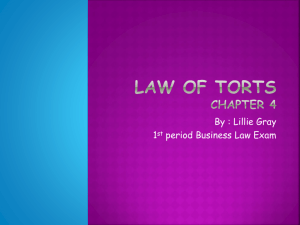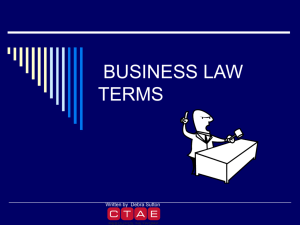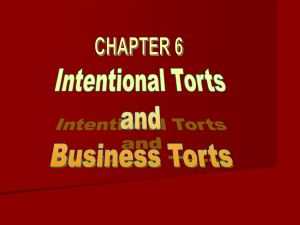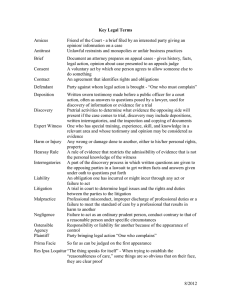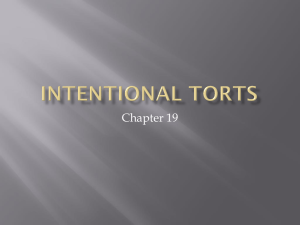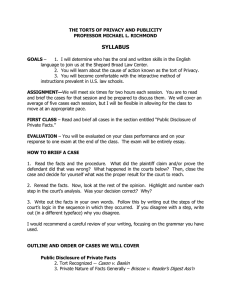- UVic LSS
advertisement
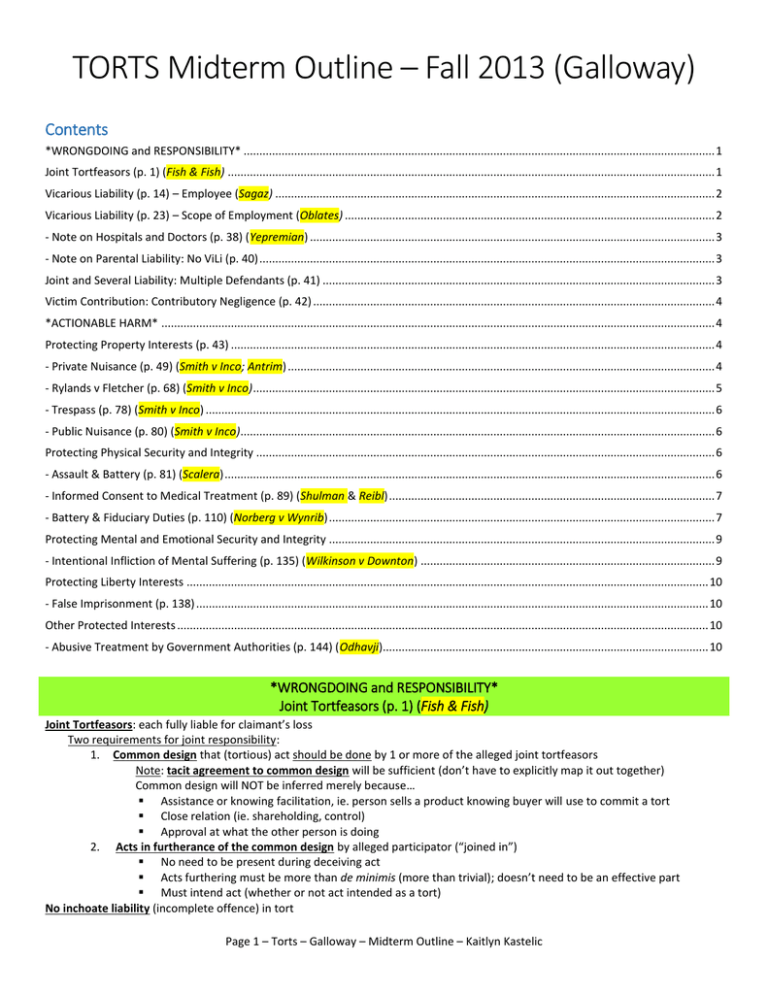
TORTS Midterm Outline – Fall 2013 (Galloway) Contents *WRONGDOING and RESPONSIBILITY* ..................................................................................................................................................... 1 Joint Tortfeasors (p. 1) (Fish & Fish) .......................................................................................................................................................... 1 Vicarious Liability (p. 14) – Employee (Sagaz) ........................................................................................................................................... 2 Vicarious Liability (p. 23) – Scope of Employment (Oblates) ..................................................................................................................... 2 - Note on Hospitals and Doctors (p. 38) (Yepremian) ................................................................................................................................ 3 - Note on Parental Liability: No ViLi (p. 40) ................................................................................................................................................ 3 Joint and Several Liability: Multiple Defendants (p. 41) ............................................................................................................................ 3 Victim Contribution: Contributory Negligence (p. 42) ............................................................................................................................... 4 *ACTIONABLE HARM* ............................................................................................................................................................................... 4 Protecting Property Interests (p. 43) ......................................................................................................................................................... 4 - Private Nuisance (p. 49) (Smith v Inco; Antrim) ....................................................................................................................................... 4 - Rylands v Fletcher (p. 68) (Smith v Inco) .................................................................................................................................................. 5 - Trespass (p. 78) (Smith v Inco) ................................................................................................................................................................. 6 - Public Nuisance (p. 80) (Smith v Inco)...................................................................................................................................................... 6 Protecting Physical Security and Integrity ................................................................................................................................................. 6 - Assault & Battery (p. 81) (Scalera) ........................................................................................................................................................... 6 - Informed Consent to Medical Treatment (p. 89) (Shulman & Reibl) ....................................................................................................... 7 - Battery & Fiduciary Duties (p. 110) (Norberg v Wynrib) .......................................................................................................................... 7 Protecting Mental and Emotional Security and Integrity .......................................................................................................................... 9 - Intentional Infliction of Mental Suffering (p. 135) (Wilkinson v Downton) ............................................................................................. 9 Protecting Liberty Interests ..................................................................................................................................................................... 10 - False Imprisonment (p. 138) .................................................................................................................................................................. 10 Other Protected Interests ........................................................................................................................................................................ 10 - Abusive Treatment by Government Authorities (p. 144) (Odhavji)....................................................................................................... 10 *WRONGDOING and RESPONSIBILITY* Joint Tortfeasors (p. 1) (Fish & Fish) Joint Tortfeasors: each fully liable for claimant’s loss Two requirements for joint responsibility: 1. Common design that (tortious) act should be done by 1 or more of the alleged joint tortfeasors Note: tacit agreement to common design will be sufficient (don’t have to explicitly map it out together) Common design will NOT be inferred merely because… Assistance or knowing facilitation, ie. person sells a product knowing buyer will use to commit a tort Close relation (ie. shareholding, control) Approval at what the other person is doing 2. Acts in furtherance of the common design by alleged participator (“joined in”) No need to be present during deceiving act Acts furthering must be more than de minimis (more than trivial); doesn’t need to be an effective part Must intend act (whether or not act intended as a tort) No inchoate liability (incomplete offence) in tort Page 1 – Torts – Galloway – Midterm Outline – Kaitlyn Kastelic Vicarious Liability (p. 14) – Employee (Sagaz) Vicarious liability: law holds one person responsible for the misconduct of another because of relationship >> Renders employers/principals liable for the wrongdoing of their employees/agents in course of employment = strict liability (no proof required of personal wrongdoing on the part of person who is subject to it) Does NOT diminish the personal liability of the direct tortfeasor Policy considerations aid in determining whether vicarious liability doctrine should be applied (purposive view): Acts authorized by principal? Principal is the superior and therefore “in charge”? Tort law is about compensation for harm; employer at best position to spread losses (internalization) Deters employers from introducing unreasonable risks and acting negligently. Ie. business bears risk of chosen activity Relationship requirements… Employer-employee relationship “contract of service” o Tortious conduct must be committed by employee in course of employment (*distinguish from frolic) Typically does not apply to relationship of employer - independent contractor “contract for services” (policy) Central question: whether the person who has been engaged to perform the services is performing them as a person in business on his own account? SAGAZ FACTORS… o Level of control (*always considered) over the direct tortfeasor (the worker): if employer does not control activities, ViLi should not be imposed; (Policy: ≠ insulated risk-taking by employer) Right to give orders and instructions to employee regarding manner to carry out work Able to reduce accidents & intentional wrongs by efficient organization and supervision NOTE a K may contain detailed specifications/conditions for an independent contractor NOTE specialized employees may exercise skills beyond ability of employers to direct o Ownership of tools / equipment o Hires his own helpers? o Degree of financial risk: risk of loss (commissions over wages) o Responsibility for investment and management o Worker’s opportunity for profit in the performance of his tasks Also note ideas of… o “Enterprise risk test”: risk trsf’d to enterprise (true cost of a product/service to be borne by enterprise offering it) o Organization test / integration test: whether work done is integral or only accessory to business; was alleged servant part of employer’s organization? *be wary / too easy to meet? Where K designates party as “independent contractor”, classification not always determinative for ViLi ViLi >> incentive to outsource (risk management); can draft “cast iron” independent contractor agreements Vicarious Liability (p. 23) – Scope of Employment (Oblates) (OLD) Salmond Test to determine vicarious liability: 1. Is it authorized by the employer? (if yes, employer is ViLi) 2. Are unauthorized acts so connected w/ authorized acts that they may be regarded as modes, although improper modes, of doing an authorized act? >> If employee was off on his own frolic, vicarious liability could not be attached to the employer **Salmond test misses the general enviro. of employment; misses purposive/policy goals better addressed by Bazley Bazley Factors (non-exhaustive list) used to determine policy reasons, to prove liability (enterprise risk test): >> Considers larger context of enterprise; risk introduced to the community >> Investigation of employee’s specific duties: special opportunities for wrong-doing? >> Must be a strong connection between wrongdoing and employee’s job in its context 1. Are there any cases that provide precedents, unambiguously suggesting a solution? 2. If not, should ViLi be imposed having regard to bigger policy goals of ViLi? (Ie. deterrence, fair compensation). Did employer create / materially enhance risk of the employee committing an intentional tort (thereby ViLi)… o Opportunity that the enterprise afford the employee to abuse power o Extent that wrongful act furthers employer’s aim (limited) o Extent that wrongful act was related to friction, confrontation or intimacy inherent in enterprise * o Extent of employee’s power in relation to the victim o Vulnerability of the potential victims of wrongful exercise of employee’s conferred power Note... Mere opportunity does not suffice to establish an employer’s ViLi. Page 2 – Torts – Galloway – Midterm Outline – Kaitlyn Kastelic - Abuse of position does not sever the connection w/ employment! Galloway: how important is the person’s role (responsible or peripheral)? - Note on Hospitals and Doctors (p. 38) (Yepremian) Hospitals - May be vicariously liable for tortious conduct of staff (staff doctors, residents, nurses) - But not for those with “hospital privileges” (not employees, though granted privilege of using facilities) Issue: Should hospitals be responsible for the actions of privately-contracted doctors? >> No, not employee (no ViLi) Plaintiff argued (unsuccessfully): doctrine of non-delegable duty applies: Hospitals have duty to take care of patients when accepted; cannot delegate duty; cannot escape liability when independent contractor Especially w/ high level of care and vulnerable people involved (no opportunity to question competency) Confusing to distinguish employee from contractor Doctrine hasn’t yet been accepted. Perhaps this is how to escape the movement towards ICs to avoid liability? - Note on Parental Liability: No ViLi (p. 40) Common Law: parents are not ViLi for torts of children UNLESS child was employed by parent or acting as their agent; grounded in parent’s wrongdoing (usually negligence); onus of proving fault rests w/ plaintiff Parental Responsibility Legislation in BC, Man, and ON (not all provinces), outline: Parents liable for intentional property damage or loss caused by their child to a maximum of $ 10,000 Statute does not impose ViLi Liability per statute is based on presumption of parental fault, unless court is satisfied a) Parent exercising reasonable supervision at time of activity that caused property loss b) Parent made reasonable efforts to prevent/discourage child from engaging in that type of activity Child conduct need not constitute a crime Determinations of reasonableness must be based on the child’s: o Age and maturity o Parent’s medical or physical conditions o Physical, emotional, psychological, or medical o Parent’s efforts to seek professional help for disabilities child or to improve parenting skills o History of destructive behaviour o Level of supervision at time of wrong-doing Joint and Several Liability: Multiple Defendants (p. 41) Negligence Act, RSBC 1996, c 333 – paraphrased - Plaintiffs can bring actions against both or either wrongdoers at once Joint tortfeasors: if the plaintiff settles the dispute with ONE defendant, they settle the dispute with ALL of them = No action can proceed against the other(s) Independent (several concurrent) tortfeasors: if plaintiff settles against one, can still bring against other independent party = An action can still proceed, although how much the plaintiff can go after is complex The plaintiff can NEVER receive more total compensation than is justified by the harm JOINT AND SEVERAL LIABILITY: Where more than 1 wrongdoer who may be acting either jointly or independently >> Ensures each is responsible for fully compensating the plaintiff. s. 4 Court must determine degree that each person was at fault. If 2 or more persons are found at fault, Plaintiff can bring action against BOTH but claim full compensation from EITHER (protects against if one has no money) o Jointly and severally liable o Between each other, in absence of a K express or implied, liable to contribute and indemnify each other in the degree to which they are respectively found to have been at fault. o Each defendant is liable for ALL the harm; Both defendants are liable for ALL the harm o Policy reasoning: better for partial wrongdoer to pay everything than plaintiff not fully compensated Page 3 – Torts – Galloway – Midterm Outline – Kaitlyn Kastelic Victim Contribution: Contributory Negligence (p. 42) Rules for multiple wrongdoers DO NOT apply when ¶ is partially responsible for own loss Contributory Negligence: failure of the plaintiff to look after his or her own well-being (see s.1 Negligence Act) Negligence Act, RSBC 1996, c 333 - paraphrased Apportionment of liability for damages s. 1 Fault of 2+ persons, damage caused to 1+ of them >> liability to make good is proportional to degree of each person’s fault o If degrees of fault cannot be established, liability divided equally o Party is liable only if partially at fault Awarding of damages s. 2 Damage/loss must be expressed in dollars Degree of fault must be expressed as % of total fault Entitled to recover % of damage from a person only corresponding to their degree of fault (no joint/several liability) Where 2 persons liable for part-liability to each other, damages offset one another (only residual amount due) Further application [of this Act] s. 8 Applies to all cases where damage is caused or contributed to by the act of a person even if another person had the opportunity of avoiding the consequences of that act and negligently or carelessly failed to do so. Policy reasons may include... The plaintiff who is insufficiently careful of her own wellbeing *ACTIONABLE HARM* Protecting Property Interests (p. 43) Smith v Inco (2011) ONCA 628 Inco operated nickel refinery in Ontario until 1985 o It is not alleged that Inco operated its refinery unlawfully or negligently (complied w/ gov’t standards) Nearby property owners: ↑levels of nickel in their soil, incorrectly reported (2000) as threat to human health (↓ value) property owners class action under 4 torts: o Private Nuisance o Trespass (dismissed by trial judge, not appealed) o Rylands v Fletcher o Public Nuisance (dismissed by trial judge, not appealed) - Private Nuisance (p. 49) (Smith v Inco; Antrim) Smith v Inco (2011) ONCA 628 cont’d Private Nuisance: indirectly causing physical injury to land OR substantially interfering w/ the use/enjoyment of land, in light of surrounding circumstances, where the injury or interference is held to be unreasonable. TWO TYPES: o Physical injury to land - Must be material, actual, readily ascertainable (observable/measurable) & substantial [detrimental effect] >> Deemed unreasonable w/o balancing competing give-and-take factors? *recent dicta suggests balance anyways! o Interference with use/enjoyment of land >> Measured by balancing competing factors to ask whether harm is unreasonable >> Severity/extent of damage, number of residents affected, residential character of the surrounding neighbourhood, and emission of particles as a by-product of a private profit-oriented business >> outweigh the utility of interference? Policy: to equip a party who is suffering damage/interference w/ means to stop the damage - Nuisance v Negligence Nuisance concerned with the actual outcome (consequences reasonable?); more like strict liability b/c no focus on ∆ conduct Negligence concerned w/ ∆ behaviour/conduct; standard of care; fault-based (this person should have acted differently) - Nuisance v Trespass Generally (may be gray area): Nuisance (indirect interference) vs. Trespass (direct interference) Antrim Truck Centre v The Queen (2013) SCC Issue to resolve: how to decide if interference w/ private use/enjoyment of land is unreasonable vs. public purpose? Ruling: interference inflicted significant/permanent loss; reasonable that individual should not be expected to bear extent of loss for the greater public good without compensation Page 4 – Torts – Galloway – Midterm Outline – Kaitlyn Kastelic - - Private Nuisance: TWO-PART TEST (must be both): 1. Substantial (non-trivial): substantially alter nature of property or significant interference w/ ¶’s actual use of property (*screens out weak claims; normal give & take in life) 2. Unreasonable (in all of circumstances) o Balancing exercise: unreasonable (character/extent) in all of circumstances to require claimant to suffer interference w/o compensation? Gravity of harm vs. utility of defendant’s conduct (not equally weighted) o Consider: severity/frequency/duration of interference, character of neighbourhood, sensitivity of plaintiff o May also consider if the defendant’s conduct was malicious or careless Burden on claimant to show that interference is substantial and reasonable Once a prima facie infringement is established, it is up to ∆ to prove his use was “natural” and not unreasonable Injurious Affection (Antrim) Statutory remedy (response to limitation in law of nuisance) Ie. serious interference of highway construction would constitute nuisance BUT constructed pursuant to statutory authority Private rights cannot be trampled upon in the name of the public good (ie. public good interests not absolute) NOT expected to endure permanent interference (↓ value of property or expropriation) w/o compensation to serve public good Central question: is harm suffered greater proportion than should be required to bear in the circumstances w/o compensation? >> Once claimant passes threshold of showing substantial harm, proceed to test of reasonableness Test for reasonableness includes balancing of factors (non-exhaustive, non-determinative) *in all cases Balancing factors: severity, nature of neighbourhood, duration, sensitivity of plaintiff etc. o Severity – if only complaint is loss of amenities (view/privacy), not as serious (may be dismissed) o Duration – ie. Temp. operations: may have to put up w/ it so long as reasonably conducted (no undue inconvenience) o Character of Neighbourhood – ie. choice of living in urban core (more public projects) considered o Conduct of Public Work - “all reasonable regard and care” (even though nuisance main concern is harm, not conduct) - Rylands v Fletcher (p. 68) (Smith v Inco) Rylands v Fletcher: imposes strict liability for damages caused to a plaintiff’s property by escape from the defendant’s property of a substance “likely to cause mischief”; recognized by SCC in Tock (1989) o Distinguish from negligence (foreseeability of risk? No reason to expect water would escape from reservoir) o Distinguish from nuisance (early nuisance only applied to ongoing interference) Rationale: entity who chooses to engage in potentially hazardous activity assumes risk of damage caused by activity (creates abnormal risk of harm to neighbour therefore responsible for harm that occurs as a consequence of risk) o Class notes: valid defenses Plaintiff’s fault (he released dangerous thing through interference) Act of God (ie. Defendant’s action greatly distanced from consequence; ie. Earthquake?) Burden of proof on person who brought dangerous thing in… to prove valid defence Four requirements: 1. Defendant made “non-natural” or “special” use of land Tock: user inappropriate to place where maintained Opt for “non-ordinary” requirement (not the law that Rylands to apply to anything not naturally found there) Consider place where use is made, time when use is made, manner of use (give-and-take btwn neighbours) Nature and degree of risk (and circumstances) inherent in the use should also be considered 2. Defendant brought on to his land something that was likely to do mischief if it escaped (dangerous) 3. Substance in question in fact escaped Connotes risk associated w/ something accidental or unintended (ie. Floods, gas leaks, etc.) Should not be limited to a single isolated escape (danger may be posed by repeated/cumulative effect) 4. Damage was caused to the plaintiff’s property as a result of the escape Trial Judge: potential emerging theory of strict liability for abnormally dangerous activities (broader than Rylands) >> leave up to Parliament Other Rylands v Fletcher factors to consider: Compliance with gov’t standards (not a defence, but still a consideration) England: added foreseeability as an element to the rule of Rylands v Fletcher (not affirmed in CND) o ONCA: not foreseeability of the escape, which would merge Rylands with liability in negligence o Foreseeability of the kind of damage? Ie. Of diminution in value of property? Note: “for general benefit of the community” usually refers to entities acting under statutory authority, engaged in activities to benefit community (or a significant segment) at large (≠ Inco’s private refinery) Page 5 – Torts – Galloway – Midterm Outline – Kaitlyn Kastelic - Trespass (p. 78) (Smith v Inco) Three types of trespass: to land, to chattels, to person (battery; assault; false imprisonment) Trespass to Land (*trespass is all about conduct) Direct physical intrusion onto land in p’s possession (direct - indirect is sometimes a difficult distinction) Need not be intentional (ie. May be trespassing even if you believe falsely that you’re on your own land) Must be voluntary (“I couldn’t help it” accepted as a defence; ie. Left on land by 3rd party while unconscious) Actionable without proof of damage o Intrusion [or touching, in trespass to person] is the harm, no need to show further damage o However, damages may be nominal if all you can show is the intrusion o Further consequential damage >> would get more damages (compensatory damages) May involve placing, propelling or discharging Plaintiff must show direct interference w/ the land (need not show more). >> Defendant to respond with defences o I am totally without fault is a full defence (ie. Involuntary) o Consent is a full defence o “I didn’t mean to” is not a full defence because he may still have been negligent o To show that they were totally without fault, the defendant must show neither intention nor negligence. Trespass as a strict liability tort (plaintiff may succeed without proving fault of defendant) Nuisance v Trespass: generally (may be gray area), Nuisance (indirect interference) vs. Trespass (direct interference) - Public Nuisance (p. 80) (Smith v Inco) Public Nuisance: activity which unreasonably interferes w/ public’s interest in health, safety, morality, comfort, or convenience Concerned w/ interference with public rights (not private rights) Where activity affects a public sector, plaintiff must show special damage (distinct from harm suffered by others) Public action may be brought by the AG (ie. to get injunction) and AG may empower private citizens to bring a public claim through a relator action. Protecting Physical Security and Integrity - Assault & Battery (p. 81) (Scalera) Assault, battery (trespass actions) Purpose: to protect a person’s physical/mental security from unwanted interference Includes direct invasion of personal autonomy, security, psychic & liberty interests Primarily for intentional interferences, but can also result from negligent conduct Emphasis: direct interference (immediate consequence of force set in motion by act of defendant) o duty/causation/remoteness that typically arise in negligence are ABSENT in trespass Actionable w/o proof of tangible harm (interference itself considered wrongful) McLachlin J (majority): Canadian Law of Battery Places the Onus of Proving Consent on the Δ Rule: ¶ in battery case must show contact through Δ’s direct, intentional act. Onus on Δ to show consent (affirmative defense) or lawful excuse - “trespass was utterly w/o his fault”; prove both unintentional and without negligence Iacobucci proposes: alter traditional rule (at least for sexual battery) to require plaintiff to prove fault (to remove unfair advantage) McL: No, protecting individuals’ right to personal autonomy Prove direct interference = prima facie, defendant should pay Onus on defendant makes practical sense (knowledge of how/why interference occurred) high demoralization cost paid by ¶ in unsuccessful action >> traditional approach to trespass: justified as a rights-based tort (compensation stems from violating right to autonomy, not fault) Tort requires contact “plus” something else (referring to non-trivial contact) ie. Harmful, offensive o Plaintiff to show triviality has been transcended Page 6 – Torts – Galloway – Midterm Outline – Kaitlyn Kastelic >> Nothing that makes it necessary to have a special rule of battery for sexual assaults for what the plaintiff must prove 1. Intuition should go with plaintiff first 2. “Smoke out the evidence” argument (onus on party who has access to information: defendant) 3. Costs of demoralization when plaintiff loses - Informed Consent to Medical Treatment (p. 89) (Shulman & Reibl) Malette v Shulman (1990) OnCA – Dr. aware of Jehovah Witness objection; performed ER blood transfusion anyways Tort of battery applies to medical treatment: protects interest in bodily security from unwanted physical interference o Defense: consent (plaintiff waives protection against intentional invasion) >> If Dr touches body of patient, it would constitute battery if patient did not consent (right to self-determination) Doctrine of informed consent: no medical procedure may be undertaken w/o informed consent provided by a capable patient informed w/ sufficient info to evaluate risks/benefits of proposed treatment and other options >> Right to refuse treatment (regardless of risk and Dr.’s opinion, even if procedure would benefit patient) Emergency: exception to general rule (requiring a patient’s prior consent) – when immediate medical treatment is necessary to save/preserve patient’s health >> Medical services lawful; Dr. privileged by reason of necessity (implied consent); not liable >> REQUIREMENTS: o Patient must be unconscious or w/o capacity to make decision (no legally-authorized agent available) o Time must be of the essence: must reasonably appear that delay until effective consent could be obtained would subject the patient to a risk of a serious bodily injury or death which prompt action would avoid o A reasonable person would consent under the circumstances (and probability that patient would consent) o - Doctrine of informed consent does not extend to informed refusal: right to refuse treatment ≠ premised on understanding of risks of refusal; religious objection does not permit scrutiny of “reasonableness” o Dr. argues: emergency health care & reason to doubt card’s validity; Dr.’s belief that in facing life/death, person will change their mind << highly objectionable by court o Right to decline medical treatment is not absolute or unqualified (ie. Preventing suicide) o Recognition of a Jehovah’s Witness’ right to refuse blood transfusions cannot be seen as threatening integrity of the medical profession or the state’s interest in protecting the same Galloway: if Dr. had data that Jehovah’s witnesses 100% of the time changed their mind (ie. A lot of experience, research paper), that could be a solid argument. Where Dr. just says I know you/your soul = not valid Reibl v Hughes (1980) SCC – plaintiff suffered massive stroke after surgery; not informed of risk of stroke prior to surgery Informed consent – required for performance of a surgical operation o Nature of proposed operation (gravity, material risks, any special/unusual risks) o If probability of a risk is very small, but caries serious consequences >> material risk requiring disclosure Trial Judge adds to duty of disclosure: o Duty does not require warning of dangers incident to any surgical procedure (ie. dangers of anaesthesia, risk of infection) which ordinary knowledge is presumed o Relates to specific risks peculiar to the contemplated treatment - - Present case: plaintiff alleges there was no informed consent (stroke after surgery, didn’t know of risk) o Plaintiff would not have consented if duty to disclose was properly executed o SCC: Uninformed consent = negligence (not battery) Inadequate disclosure of risks is not a test of the validity of the consent; uninformed consent is still consent >> Valid defense against battery Battery should only apply to surgery where a DIFFERENT surgery was performed than consented Where duty of disclosure was inadequately performed >> action in negligence (did not invade patient’s body, because consent for that specific surgery was received) Distinction between failing to tell risks vs. misrepresentation Proper battery case: Marshall v Curry (1933): consent given to hernia-removal operation; Dr. removes testicle >> battery. [Health Care (Consent) and Care Facility (Admission) Act, RSBC 1996, C 181) - Battery & Fiduciary Duties (p. 110) (Norberg v Wynrib) Norberg v Wynrib (1992) SCC – drug addict patient trades Dr. painkillers for sexual favors; did not help treat addiction La Forest (majority) (SCC) Battery Page 7 – Torts – Galloway – Midterm Outline – Kaitlyn Kastelic Sexual assault in this case falls under tort of battery (not considering fiduciary duty b/c looking at assault) Battery: intentional infliction of unlawful force on another person (para 26): Consent, express or implied, is a defence to battery o Failure to resist or protest is an indication of consent (if reasonable person would have voiced objection) Galloway: this is NOT applicable to medical consent o Consent must not involve force, threat of force, fraud/deceit or incapacity La Forest: this ^^ approach to consent in this case is too limited - Consent is based on presumption of individual autonomy and free will >> Must be modified to appreciate power relationship between parties; inherently suspect in power-dependency relationships Inequality of bargaining power: intellectual, economic, or situational because of temporary circumstances, or; “weakness” may arise out of a special relationship involving trust and confidence. (para 33) In certain circumstances, consent will be considered legally ineffective if it can be shown that there was such a disparity in the relative positions of the parties that the weaker party was not in a position to choose freely. Finds no consent because it was an unconscionable transaction (based on K law idea). 2-part test for genuine consent: 1. Power imbalance (proof of inequality); special power/dependency relationship 2. Exploitation (proof of an improvident bargain) Central question: Is sexual relationship one that is sufficiently divergent from community standards of conduct? Court will invoke equitable rule that a person who is not equal to protecting himself will be protected, not against his own folly or carelessness, but against his being taken advantage of >> Unequal power + exploitative nature of relationship >> removed the possibility of the appellant’s providing meaningful consent to sexual contact (para 48); defence of consent cannot succeed La Forest on damages Battery is actionable w/o proof of damage General damages: assessed considering aggravating features of case (which ↑ award) o Aggravated damages may be awarded if battery occurred in humiliating/undignified circumstances (not in addition to general damages) **designed to compensate Punitive damages: where ∆ conduct harsh, vindictive, reprehensible, malicious; extreme in nature **to punish Present case: o Repeat encounters, power difference exploit, sustained mental harm to ¶ >> $ 20,000 aggravated damages o Deterrence objectives; used power for sexual favors: offensive, reprehensible >> $ 10,000 punitive damages McLachlin +1 (SCC) – Consent (not assault/battery), but breach of fiduciary duty Focus on fiduciary relationship (rather than doctrine of tort or K) to capture essential nature of the wrong Situating harm in the structure of the relationship; K ill-fitting, provides poor characterization of the relationship and wrong Breach of fiduciary duty o Essence of tort or contract relationships: balance of independent, equal actors acting in self-interest o Essence of fiduciary relationship: 1 party exercises power on behalf of another, pledges best interest Trust (not self-interest) at the core; deeper implications of a power imbalance o Characteristics of a fiduciary relationship (para 69) 1. Fiduciary has scope for exercise of some discretion or power 2. Fiduciary can unilaterally exercise that power/discretion to affect beneficiary’s legal or practical interests 3. Beneficiary is peculiarly vulnerable to or at mercy of fiduciary holding the power/discretion Note: vulnerability stems from the structure and nature of the fiduciary nature; physical or emotional o Characteristics of a fiduciary relationship (para 97): 1. Imbalance of power 2. Potential for interference w/ a legal interest or a non-legal interest of “vital and substantial ‘practical’ interest” 3. Requirement that the fiduciary has assumed or undertaken to “look after” the interest of the beneficiary o Duties as a fiduciary: loyalty, good faith and avoidance of a conflict of duty and self-interest o Concern with the protection of both societal and personal interest - Damages >> Fiduciary relationship and breach in present case o Fiduciary duty adds level of comprehension and adequate compensation o Wrongful sexual exploitation enters exclusive terrain of equity (unlike tort/contract) Goal of equity: restore ¶ to position as though equitable breach ≠ occur (restorative remedial approach) Present case: loss is not economic (injuries: prolonged her addiction and sexual violation) Page 8 – Torts – Galloway – Midterm Outline – Kaitlyn Kastelic >> $ 20,000 suffering and loss during period of prolonged addiction >> $ 25,000 for sexual exploitation >> $ 25,000 punitive damages: actions of fiduciary were repugnant to beneficiary`s best interests (breaching position of trust), motivated by self-interest, lack of concern for victim (*not to compensate, but to punish the wrongdoer and deter both him and others) = $ 70,000 total Sopinka (SCC) – Negligent Breach of Duty (contractual or tortious breach of the physician’s duty to his patient) SCC on ex turpi causa Defence of ex turpi causa – both parties voluntarily participated in illicit relationship; injury a direct cause of illegal/immoral acts Ex turpi applies when people are involved in a criminal activity, and is such that recognizing a tort would really undermine the law to try the case – but an exceptional “defence” Participants in a joint criminal activity do not owe a duty to each other >> No ex turpi causa applicable here There must be a common purpose: one criminal illegality to which both were parties. (Locke JA(dissent) Court of Appeal) No causative link between injury and crime committed by the appellant. “Double-doctoring” was irrelevant to the transaction between the parties (ie. if she only had one Dr. for prescription, would still have suffered harm) (La Forest, SCC) Dr. discharging proper duty, should have refused further drugs and referred to professional treatment; exploited situation instead! To allow ex turpi causa would be to blame the victim (McLachlin, SCC) Protecting Mental and Emotional Security and Integrity - Intentional Infliction of Mental Suffering (p. 135) (Wilkinson v Downton) Tort of Intentional Infliction of Mental Suffering - allows a plaintiff to recover damages in situations where a tortfeasor has intentionally caused mental distress Person who makes a false statement intended to be acted on must make good the damage naturally resulting from being acted on ∆ wilfully done an act intended to cause harm (infringing right to safety); foreseeable effect (therefore imputed intention?) Consequence not too remote (sufficiently close and complete connection between cause and effect) Elements of the tort of intentional infliction of mental suffering (Bullock): 1. An act or statement o Outrageous or extreme, bullying, harassment, etc. 2. Intended/ calculated to produce harm (willfulness/malice) o Therefore infringe on person’s right to safety o Court can construct intent (constructive intent) o Do so by using the reasonable person: if they behave in such a fashion, a reasonable person would’ve been harmed 3. Actual harm a. Must be substantial; until recently, courts seem to require expert evidence or diagnosis (ie. something w/ a name) Reluctant to recognize emotional distress tort b/c of floodgates (false, trivial and numerous actions; unusually sensitive persons) o Control mechanisms: Reasonableness: Objective standard (ie. overly sensitive ≠ a case UNLESS ∆ knew of sensitivity) Proof of harm required: more recently, accepting w/o evidence when conduct sufficiently outrageous - In Victorian Railways Commissioners v Coultas, Privy Council held illness from shock was too remote a consequence of a negligent act which caused the fright; no physical harm immediately caused [not relevant to this case; b/c no wilful wrong] Smith v Johnson: man killed in sight of plaintiff by defendant’s negligence, plaintiff became ill (not from shock from fear of harm to himself) but from seeing another person killed >> harm too remote a consequence of the negligence Court Ruling Defendant wilfully did an act to cause harm to the plaintiff, and caused harm >> good cause for action (new tort) Element of intention is made out in case, b/c defendant wanted some sort of shock result Damages Awarded compensation for both expenses and shock injury (reasonable person would suffer grave effects from hearing news) Page 9 – Torts – Galloway – Midterm Outline – Kaitlyn Kastelic Protecting Liberty Interests - False Imprisonment (p. 138) Lumba v Secretary of the State for the Home Department (2011) UKSC – FNP’s detained pending deportation (unpublished policy) Rights of liberty is of fundamental importance Courts should strictly/narrowly construe statutory powers that restrict fundamental rights Factors in determining lawfulness of a detention allowed by administrative directive: 1. Must not be a blanket policy admitting no possibility of exceptions 2. If unpublished, must not be inconsistent with any published policy (duty of consistent application of policies (non-arbitrary)) 3. Should be published if it will inform discretionary decisions (where potential object of those decisions has a right to make representations) (Rule of law calls for transparent statement; identified through formulated policy statements) Requirements for False Imprisonment Detention Absence of lawful authority to justify it Where detainer is a public authority, must have power to detain and power must be lawfully exercised Requirements to bring action Claimant has to prove he was detained Detainer/state must prove that the detention was justified in law (cannot do so by showing that, although decision to detain was tainted by public law error, a decision to detain free from error could and would have been made). >> Causation Test inappropriate (ie. even though claimants would’ve been detained regardless)!! o Causation Test in tort of false imprisonment is contrary in principle to both law of trespass to person and administrative law (neither recognizes defense of causation to render lawful what was unlawful authority to detain) >> focus on how it did in fact act (not on how would have acted) Trespassory torts (ie. false imprisonment) are actionable per se (regardless of whether victim suffers harm; ie. even if victim does not know he was imprisoned) vs. negligence which regards damage as essence of the wrong. Damages If person unaware of false imprisonment and suffered no harm >> no more than nominal damages Purpose of damages is to compensate victims of civil wrongs for the loss and damage caused (no loss here, awarded £ 1) Other Protected Interests - Abusive Treatment by Government Authorities (p. 144) (Odhavji) Action for Misfeasance in a public office SCC: Tort is broadly based on unlawful conduct in the exercise of public functions generally Defining elements of the tort: o Includes exercise of powers which official does not possess in law o Any act or omission (where legal obligation to act) done or made by a public official in the purported performance of the functions of the office can be found an action for misfeasance in public office - Essential Ingredients of the tort: Must prove common constituent elements: 1. Public officer must have engaged in deliberate and unlawful conduct in his/her capacity as public officer 2. Public officer must have been aware both that conduct was unlawful and that it was likely to harm plaintiff (ie. bad faith, ulterior motive, dishonesty; or mind of reckless indifference; tort arises w/ duty owed to plaintiff as an individual) *subjective awareness (“ought to have known” does not suffice) ++ Requirements common to all torts: tortious conduct caused injury and that injuries are compensable in tort law >> 2 ways (categories) to commit the tort (different manners to prove tort): o Category A – involves conduct that is specifically intended to injure a person or class of persons >> Fact that officer acted for express purpose of harming ¶ satisfies both ingredients, owing that officer does not have authority to exercise power for improper purpose, ie. deliberate harm to member of public o Category B – involves a public officer who acts w/ knowledge both that has no power to do the act and likely to injure ¶ >> must prove the 2 ingredients of the tort independently of one another - Misfeasance in a public officer does not include: o Officer who inadvertently or negligently fails adequately to discharge obligations Page 10 – Torts – Galloway – Midterm Outline – Kaitlyn Kastelic o o o Officer who fails to discharge obligations due to budgetary constraints Officer who is unable to discharge obligations b/c of factors beyond control Officer where there is a conflict between statutory obligations and his constitutionally protected rights (ie. right against self-incrimination); obligation thereby unlawful >> Rather, it applies to officer who could have discharged obligations but wilfully chose not to - Policy: to protect each citizen’s reasonable expectation that a public officer will not intentionally injure a member of pubic through deliberate and unlawful conduct in exercise of public functions - DISTINGUISH from negligent excess of power: act committed w/o knowledge of (subjective recklessness as to) its unlawfulness and probable consequences for the plaintiff Page 11 – Torts – Galloway – Midterm Outline – Kaitlyn Kastelic
